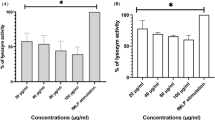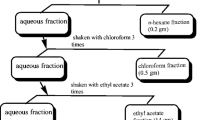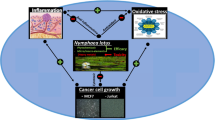Abstract
Aphloia theiformis (Vahl) Benn. is used as ethnical medicine for diverse diseases in the Indian Ocean islands and the East Africa region. This study investigated the potential immunomodulatory effect of the phenolic fraction of A. theiformis leaves and their anti-inflammatory potent. Phenolic fraction from the leaves of A. theiformis was obtained by methanol extract, and recovered by an aqueous solution of 5% HCl, then filtered. We investigated the potential immunomodulatory effect in rat, by flow cytometer. Anti-inflammatory activity was also investigated in carrageenan-induced paw oedema rat model. Results demonstrated an immunosuppressive effect on lymphocyte for all doses administered. However, we noted an interesting immunostimulant effect on monocytes and granulocytes number at high doses. Then, we noted an important anti-inflammatory-like effect for these doses in vivo. This work suggests the eventual use of this plant in the treatment of some inflammatory symptoms and immune dysfunctions.
Résumé
Extrêmement répandu dans les îles de l’océan Indien, Aphloia theiformis est très utilisée contre diverses maladies. Dans cette étude, nous nous sommes penchés sur les possibles effets immunomodulateur et anti-inflammatoire de la fraction phénolique d’Aphloia theiformis. Cette fraction phénolique est obtenue à partir de l’extrait méthanolique des feuilles d’Aphloia theiformis après récupération par une solution d’HCl à 5 %. L’activité immunomodulatrice a été réalisée par cytométrie en flux, et l’activité anti-inflammatoire par le biais du modèle d’oedème de la patte induit par la carragénine chez le rat. Pour ce qui est de l’activité immunomodulatrice, les résultats ont montré un effet suppressif sur les lymphocytes pour toutes les doses testées. Cependant, pour les doses élevées, on a noté un intéressant effet immunostimulant pour les sous-populations monocytaires et granulocytaires, suggérant ainsi un potentiel effet anti-inflammatoire qui a été démontré in vivo. Ces résultats ouvrent donc la voie à une utilisation potentielle de cette plante dans le traitement des symptômes inflammatoires et certains dysfonctionnements de la réponse immunitaire.
Similar content being viewed by others
References
World Health Organization (WHO) (2002) WHO Traditional Medicine Strategy 2002–2005
Cragg GM, Boyd MR, Khanna R, et al. (1999) International collaboration in drug discovery and development: the NCI experience. Pur Appl Chem 71:1619–33
Cheng W, Li J, You T, Hu C (2005) Anti-inflammatory and immunomodulatory activities of the extracts from the inflorescence of Chrysanthemum indicum Linné. J Ethnopharmacol 101:334–7
Patwardhan B, Manish G (2005) Botanical immunodrugs: scope and opportunities. Drug Discovery Today 10:495–502
Ishizuka M, Kawatsu M, Yamashita T, et al. (1995) Low molecular weight immunomodulators produced by microorganisms. Int J Immunopharmacol 17:133–9
Danthu P, Lubrano C, Flavet L, et al. (2010) Biological Factors Influencing Production of Xanthones in Aphloia theiformis. Chem Biodiv 7:140–50
Kaou AM, Mahiou-Leddet V, Hutter S, et al. (2008) Antimalarial activity of crude extracts from nine African medicinal plants. J Ethnopharmacol 116:74–83
Jonville MC, Kodja H, Humeau L, et al. (2008) Screening of medicinal plants from Reunion Island for antimalarial and cytotoxic activity. J Ethnopharmacol 120:382–6
Rasoanaivo P, Petitjean A, Ratsimamanga-Urverg S, Rakoto-Ratsimamanga A (1992) Medicinal plants used to treat malaria in Madagascar. J Ethnopharmacol 37:117–27
Lavergne R (1983) Fleurs de Bourbon, Tome 8. Cazal, Saint-Denis, La Réunion, p. 288
Maiza-Benabdesselam F, Khentache S, Bougoffa K, et al. (2007) Antioxidant activities of alkaloid extracts of two Algerian species of Fumaria: Fumaria capreolata and Fumaria bastardii. Rec Nat Prod 1:28–35
Hajaji HE, Lachkar N, Alaoui K, et al. (2011) Antioxidant activity, phytochemical screening, and total phenolic content of extracts from three genders of carob tree barks growing in Morocco. Arab J Chem 4:321–4
Hadj Salema J, Chevalota I, Harscoat-Schiavoa C, et al. (2011) Biological activities of flavonoids from Nitraria retusa (Forssk.) Asch. and their acylated derivatives. Food Chem 124:486–94
Ghosh MN (1984) Fundamentals of experimental pharmacology. In: Statistical Analysis, 2nd ed, Scientific Book Agency Calcutta, pp187–9
Miller LC, Tainter ML (1944) Estimation of LD50 and its error by means of log-probit graph paper. Proc Soc Exp Biol Med 57:261–4
Randhawa MA (2009) Calculation of LD50 values from the method of MILLER and TAINTER, 1944. J Ayub Med Coll Abbottabad 21:184–5
Winter CA, Risley EA, Nuss CW (1962) Carageenan-induced oedema in hind paws of the rat as an assay for anti-inflammatory drugs. Proc Soc Exp Bio Med 111:544–7
Lavergne R (2008) 11 plantes de la pharmacopée réunionnaise. Accessed 2011 January 29; Available on http://les-habitants-sentinelles.over-blog.com/
Gopalsamy N, Vargas D, Guého J, et al. (1988) Saponins from leaves of Aphloia theiformis. Phytochem 27:3593–5
Atluru S, Atluru D (1991) Evidence that genistein, a protein-tyrosine kinase inhibitor, inhibits CD28 monoclonal-antibody-stimulated human T cell proliferation. Transplantation 51:448–50
Huang HC, Hsieh LM, Chen HW, et al. (1994) Effects of baicalein and esculetin on transduction signals and growth factors expression in T-lymphoid leukemia cells. Eur J Pharmacol 268:73–8
Li SY, Teh BS, Seow WK, et al. (1991) In vitro immunopharmacological profile of the plant flavonoid baohuoside-1. Int J Immunopharmacol 13:129–34
Pandey R, Maurya R, Singh G, et al. (2005) Immunosuppressive properties of flavonoids isolated from Boerhaavia diffusa Linn. Int Immunopharmacol 5:541–53
Chang SL, Chiang YM, Chang CLT, et al. (2007) Flavonoids, centaurein and centaureidin, from Bidens pilosa, stimulate IFN-? expression. J Ethnopharmacol 112:232–6
Chaubal R, Deshpande VH, Deshpande NR (2005) Methyl gallate, the medicinally important compound: a review. J Environ Agric Food Chem 4:956–62
Muruganandan S, Lal J, Gupta PK (2005) Immunotherapeutic effects of mangiferin mediated by the inhibition of oxidative stress to activated lymphocytes, neutrophils and macrophages. Toxicol 215:57–68
Vinegar R, Schreiber W, Hugo R (1969) 5,6-dihydroxytryptamine. Different effects in the Biphasic development of carrageenan oedema in rats. J Pharmacol Exp Ther 166:96–103
Chi YS, Jong HG, Son KH, et al. (2001) Effects of naturally occurring prenylated flavonoids on enzymes metabolizing arachidonic acid: cyclooxygenases and lipoxygenases. Biochem Pharmacol 62:1185–91
Havsteen BH (2002) The bioactivity and medical significance of the flavonoids. Pharmacol Ther 96:67–202
Middleton E, Kandaswami C, Theoharides TC (2000) The effects of plant flavonoids on mammalian cells: implications for inflammation, heart disease and cancer. Pharmacol Rev 52:673–751
Küpeli E, Yesilada E (2007) Flavonoids with anti-inflammatory and antinociceptive activity from Cistus laurifolius L. leaves through bioassayguided procedures. J Ethnopharmacol 112:524–30
Rotelli AE, Guardia T, Juarez AO, et al. (2003). Comparative study of flavonoids in experimental models of inflammation. Pharmacol Res 48:601–6
Toker G, Küpeli E, Memisoglu M, Yesilada E (2004) Flavonoids with antinociceptive and anti-inflammatory activity from the leaves of Tilia argentea (Linden). J Ethnopharmacol 95:393–7
Matsuda H, Ninomiya K, Shimoda H, Yoshikawa M (2002) Hepatoprotective principles from the flowers of Tilia argentea (Linden): Structure requirement of tiliroside and mechanism of action. Bioorg Med Chem 10:707–12
Olajide OA, Makinde MJ, Awe SO (1999) Effects of the aquous extract of Bridelia ferruginea stem bark on carrageenan-induced oedema and granuloma tissue formation in rats and mice. J Ethnopharmacol 66:113–7
Author information
Authors and Affiliations
Corresponding author
About this article
Cite this article
Hsoidrou, S., Bousta, D., Lachkar, M. et al. Phytochemical screening, immunomodulatory and anti-inflammatory activities of the phenolic fraction of Aphloia theiformis (Vahl) Benn. plant used in comorian traditional medicine. Phytothérapie 12, 354–359 (2014). https://doi.org/10.1007/s10298-014-0875-1
Published:
Issue Date:
DOI: https://doi.org/10.1007/s10298-014-0875-1
Keywords
- Aphloia theiformis (Vahl) Benn.
- Immunomodulatory
- Anti-inflammatory
- Phytochemical screening
- Phenolic fraction




